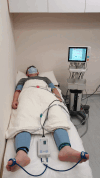Cardio-Ankle Vascular Index: Test-Retest Reliability and Agreement in People With Stroke
- PMID: 39508121
- PMCID: PMC11614752
- DOI: 10.1111/nhs.13191
Cardio-Ankle Vascular Index: Test-Retest Reliability and Agreement in People With Stroke
Abstract
The cardio-ankle vascular index (CAVI) is superior to traditional methods of measuring arterial stiffness. However, its application in clinical practice has lagged behind the science. This study aimed to (1) examine its test-retest reliability and agreement between repeated measurements, (2) identify the correlation with fatigue and sleep quality, and (3) compare the CAVI values of the bilateral sides of people with stroke, and those of stroke survivors with and without fatigue. Participants (n = 67) were assessed using the CAVI, Fatigue Assessment Scale, and Pittsburgh Sleep Quality Index. The test-retest reliability ranged from 0.77 to 0.86. The Bland-Altman plots showed good agreement between test and retest. The standard error of measurement ranged from 0.59 to 0.66. The minimal detectable change ranged from 1.15 to 1.29. The CAVI values of the bilateral sides correlated with fatigue and those at the paretic side correlated with sleep quality. The CAVI values of the paretic side were higher than those of the non-paretic side in people with stroke. Stroke participants with fatigue had higher CAVI values than those without fatigue. CAVI has good test-retest reliability and agreement between repeated measurements for clinical use.
Keywords: cardio‐ankle vascular index; fatigue; sleep quality; stroke; vascular stiffness.
© 2024 The Author(s). Nursing & Health Sciences published by John Wiley & Sons Australia, Ltd.
Conflict of interest statement
The authors declare no conflicts of interest.
Figures



References
-
- Asmar, R. 2017. “Principles and Usefulness of the Cardio‐Ankle Vascular Index (CAVI): A New Global Arterial Stiffness Index.” European Heart Journal Supplements 19, no. suppl_B: B4–B10. 10.1093/eurheartj/suw058. - DOI
-
- Bond, J. , Nielsen T., and Hodges L.. 2021. “Effects of Post‐Exertional Malaise on Markers of Arterial Stiffness in Individuals With Myalgic Encephalomyelitis/Chronic Fatigue Syndrome.” International Journal of Environmental Research and Public Health 18, no. 5: 2366. 10.3390/ijerph18052366. - DOI - PMC - PubMed
MeSH terms
Grants and funding
LinkOut - more resources
Full Text Sources
Medical

